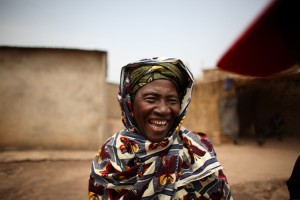Erratic rain and climate change

Moh Mariko was not sure what year she was born, since it isn’t important and no one pays attention to such things in her village in southern Mali. “I was born in the year when there was a lot of rain,” she says. (Her government ID said it was 1945.)
Rain, that’s the important thing in the Sahel. When there is none, people suffer terribly. They can’t grow crops to feed themselves, and they can’t grow cotton to sell for cash, so they can’t support their families with enough food, medicine, and clothes and books and school fees for their children.
It’s a tough life in the Sahel because the amount of rainfall varies from one year to the next. This makes the threat of climate change even greater. It’s a concern raised in the wake of a paper published in the magazine Science this month that explores a long-term history of drought in West Africa and says that the region could experience more drought due to increased greenhouse gases and climate change. A story about this report in the New York Times last week quotes Kevin Watkins, who used to work for Oxfam and is now with the UN Development Programme. He says the report could represent “early warning signs of an unprecedented and catastrophic reversal in human development.”

Right after I met Moh Mariko, I met Omar Songo in Bamako. He had just started working for Oxfam in Mali, and his job is to help the organization learn how people like Mariko can react, adapt, and survive in a changing climate. Having grown up near Timbuktu, on the doorstep of the Sahara, he knows how hard it is for farmers in Mali. “Rain is the biggest factor of vulnerability for farmers,” he confirms, along with soil quality, which is deteriorating due to chemical fertilizers and deforestation.
Songo and others working for Oxfam in Mali are researching what to do. “We are looking at different varieties of seeds for rice, millet, sorghum…these are the main food crops for sale. Some you can only grow in the rainy season. Others can be grown in times when there is not as much rain, such as vegetables you can grow in a garden with water from a well. Women are doing this now, and maybe they can do it more.”

Different seeds, different planting times, different ways of managing fields and water, all these ideas must be researched in order to determine the best strategies for farmers in the Sahel. Omar Songo says that the farmers themselves should be part of these solutions: “At the local level, people have their own understanding of climate change. They see the changes themselves, so the question is, what are they seeing? Before we can intervene we need to understand their knowledge, this is essential.”
Countries like Mali will need the right kind of resources to learn how to help people like Moh Mariko survive drought. Those of us who have contributed the most to the build-up of greenhouse gasses in our atmosphere have a responsibility to help. In the coming months, there are some opportunities to create the political will to produce this essential assistance, from legislation in Washington to ongoing international negotiations culminating in Copenhagen in December. I’m hoping we all maximize opportunities to support farmers in Mali as they cope with the changing climate.